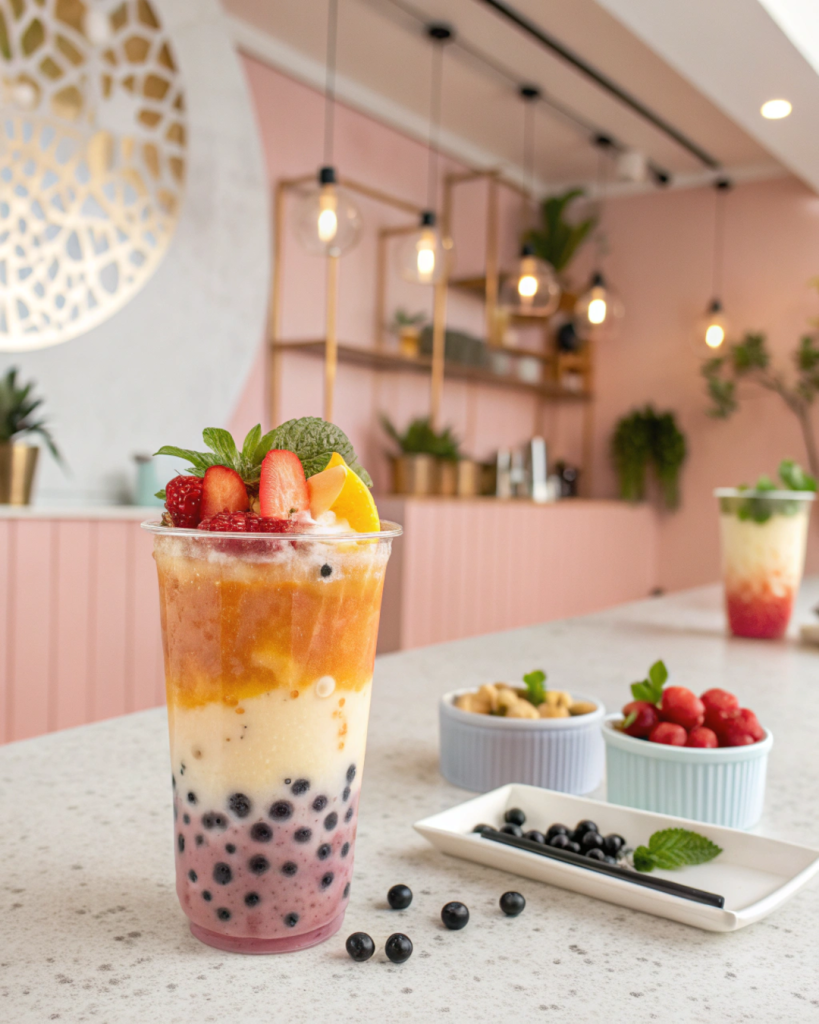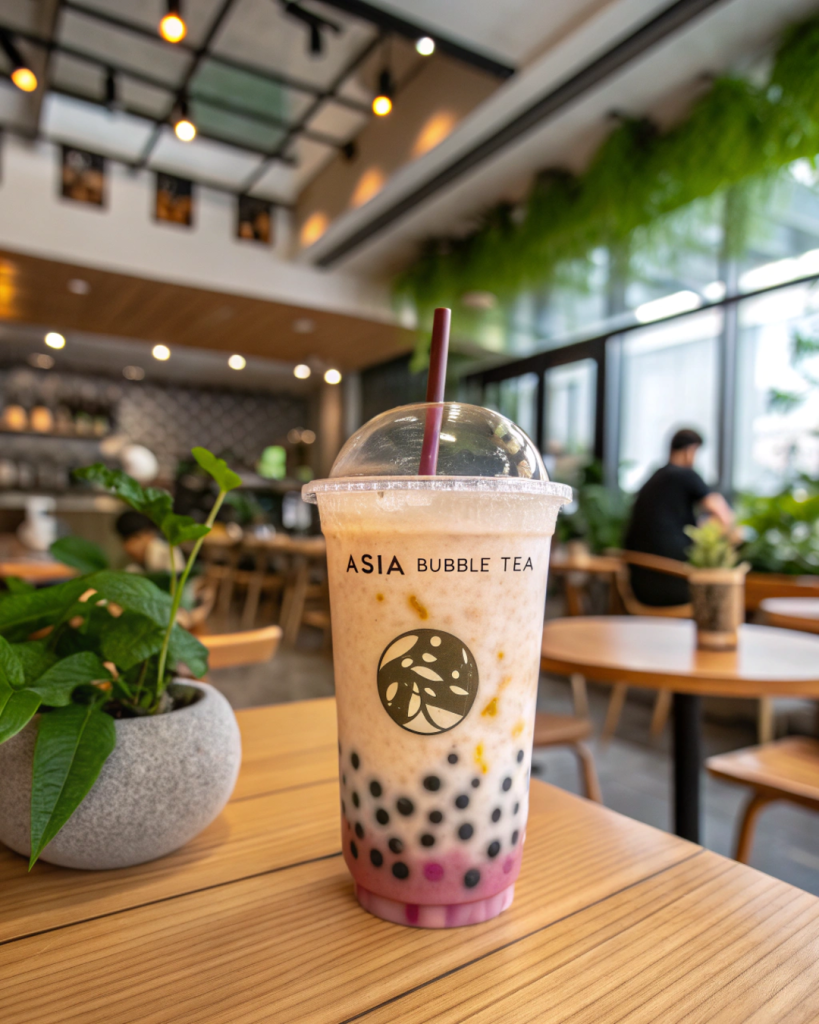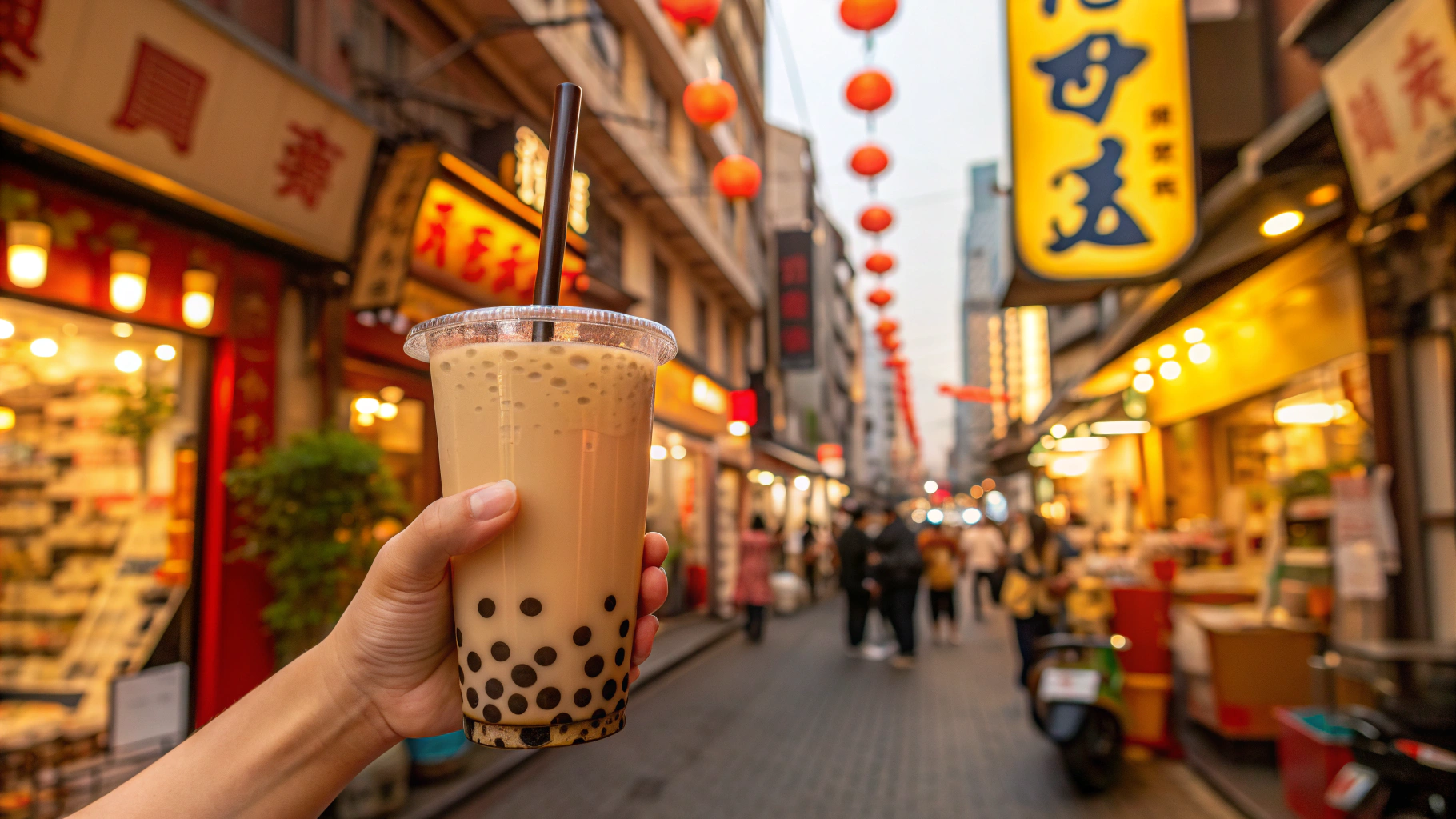I’ll never forget my first proper bubble tea experience. It was in a tiny Taiwanese tea shop in Taichung, and I’d just spent the previous 20 minutes watching locals customize their drinks with an intensity usually reserved for wine sommeliers. When the cashier asked me about ice levels, sweetness, and toppings, I panicked and just blurted out “normal everything!” The drink that arrived—a perfectly balanced pearl milk tea with those iconic chewy tapioca balls—changed everything I thought I knew about tea.
That sweet, creamy concoction with its distinctive chewy pearls wasn’t just a drink; it was my gateway into understanding a beverage culture that has captivated all of Asia and beyond. If you’re planning a trip across this incredible continent, understanding bubble tea—also known as boba, pearl milk tea, or simply “that Asian drink with pearls”—is essential to experiencing authentic local life.
The Taiwanese Origin Story You Need to Know
Every great travel story starts with understanding where something comes from, and bubble tea’s origin is delightfully disputed. The beverage originated in Taiwan during the 1980s, a period of significant economic growth when the island’s food innovation was exploding.
Two competing stories claim the title of “bubble tea birthplace,” and honestly, both are worth visiting. The first credits Tu Tsong-he, owner of Hanlin Tea Room in Tainan, who in 1986 spotted tapioca balls at a local market and decided to add them to his green tea—a childhood memory turned beverage revolution. The second, more widely recognized story, comes from Chun Shui Tang teashop in Taichung, where in 1987, product development manager Lin Hsiu Hui poured her tapioca dessert into iced tea during a staff meeting, creating the iconic combination we know today.
What makes this origin story so beautifully Taiwanese is that it wasn’t planned—it was experimental, playful, and rooted in taking traditional elements (tea, tapioca) and reimagining them completely. That innovative spirit is something you’ll feel in every bubble tea shop across Asia today.
Why Bubble Tea Became Asia’s Most Addictive Drink

Walking through any major Asian city today, you’ll notice bubble tea shops on virtually every corner. This isn’t an exaggeration—Thailand alone has over 31,000 bubble tea stores, and Southeast Asia’s annual spending on bubble tea reaches a staggering $3.66 billion.
The drink’s appeal goes beyond just taste. Bubble tea represents customization culture at its finest—you control the sweetness level, ice amount, tea base, milk type, and toppings, creating a drink that’s uniquely yours. This resonates deeply with younger Asian consumers who value personalization and Instagram-worthy experiences.
From Taiwan, bubble tea spread rapidly throughout Asia in the 1990s and 2000s. Major chains like Chatime, Coco, Gong Cha, and Koi brought the drink to Hong Kong, Singapore, Thailand, Malaysia, and beyond. Each country adapted it to local tastes—you’ll find taro bubble tea dominating in some regions, while fruit teas reign supreme in tropical Southeast Asia.
Your Ultimate Guide to Ordering Bubble Tea Across Asia
One of my biggest travel mistakes was confidently ordering bubble tea without understanding what I was asking for. I ended up with a drink so sweet it could’ve doubled as dessert, with zero ice on a 35°C Bangkok afternoon. Learn from my mishap—here’s how to navigate the ordering process like a local.
Understanding the Menu
Most bubble tea shops organize their menus into categories: milk tea, fruit tea, classic tea, cheese foam tea, and smoothies. Milk tea is the traditional creamy option, while fruit teas are lighter and often more refreshing in hot climates.
The Customization Questions
After choosing your flavor, you’ll be asked several standard questions. Size options typically include small, medium (中杯, zhōngbēi), and large (大杯, dàbēi). Then comes sweetness: full sugar (全糖), half sugar (半糖), 30% sugar, or no sugar (無糖). For hot Asian climates, I recommend 30-50% sweetness—you’ll still get flavor without the sugar overload.
Ice levels follow next: full ice (正常冰), less ice (少冰), or no ice (去冰). Here’s an insider tip: ordering “less ice” means more actual drink in your cup, which is why locals often choose this option.
Choosing Your Pearls and Toppings
The iconic tapioca pearls (珍珠, zhēnzhū) are the classic choice—chewy, slightly sweet, and perfectly satisfying. But Asia’s bubble tea scene has exploded with creative toppings: taro pearls, coconut jelly (椰果), red beans, popping boba, cheese foam, and even konjac balls.
During my travels, I discovered that different cities have signature styles. Taiwan favors traditional tapioca with brown sugar syrup, Hong Kong loves cheese foam teas, and Thailand experiments with tropical fruit combinations you won’t find elsewhere.
Must-Visit Bubble Tea Destinations in Asia
Taiwan: The Undisputed Bubble Tea Capital
No Asia trip focused on bubble tea is complete without Taiwan. This island is where the magic began, and the quality, variety, and sheer passion for bubble tea here remain unmatched.
Start at Chun Shui Tang in Taipei or Taichung—one of the original bubble tea inventors. Their original pearl milk tea is a pilgrimage drink for boba enthusiasts, though expect 20-30 minute waits at popular locations. You can even take DIY bubble tea classes at the original Taichung location, learning to make your own pearls from scratch.
For adventurous travelers, skip the tourist traps and explore local favorites. The Oolong Project near Daan Park in Taipei uses single-origin leaves from Nantou, creating intense, roasted oolong milk tea where you actually taste the tea, not just sugar. Good Day Tea in Taichung serves roasted Tieguanyin brown sugar milk tea with house-cooked pearls that taste almost caramelized.
Budget travelers will love that quality bubble tea in Taiwan costs just NTD 40-80 (approximately $1.20-$2.50 USD) at local shops, though premium spots may charge NTD 100-150. Compare that to the same quality drink elsewhere, and Taiwan is unbeatable value.
Hong Kong: Where Bubble Tea Gets Premium
Hong Kong’s bubble tea scene is characterized by premium brands and creative innovations. The city has over 60 active bubble tea brands, with the highest average prices in Southeast Asia—nearly double other regional markets.
HEYTEA, a premium Chinese brand, made its Southeast Asian debut in Hong Kong and remains incredibly popular for cheese foam teas and seasonal fruit creations. The Alley, recognizable by its deer logo, serves addictive “crunchy milk tea with brown sugar jelly” and snow velvet peach oolong with creamy cheese topping.
For health-conscious travelers, Mother Pearl offers Hong Kong’s only vegan bubble tea, made entirely from scratch with plant-based milk, superfood tapioca, and natural sweeteners instead of refined sugar. Their Matcha Crush and Very Berry Crush are Instagram-worthy and guilt-free.
Singapore: The Southeast Asian Hub
Singapore’s position as a wealthy, cosmopolitan city makes it the perfect testing ground for premium bubble tea brands. With disposable income to spare, Singaporeans have driven innovation in the bubble tea market.
Silk, Hong Kong’s number one brand, recently opened in Singapore at Orchard Gateway, bringing their signature cheese foam refills (available for 30 minutes after purchase) and HK-style milk tea to Singaporean fans. Their Matcha Cheese Cloud topped with creamy cheese foam has already developed a cult following.
Budget tip: While Singapore’s premium brands can cost $6-8 SGD per drink, local chains and neighborhood shops offer quality bubble tea for $3-5 SGD, making it more accessible for backpackers.
Bangkok and Thailand: Budget Bubble Tea Paradise

Thailand’s bubble tea market generates $749 million annually through its 31,000+ stores, making it one of the most saturated and competitive markets in Asia. For travelers, this means incredible variety and rock-bottom prices.
Bangkok has some of the world’s cheapest bubble tea, with prices ranging from 20-100 baht ($0.60-$3.00 USD). In less touristy areas outside Platinum Mall and major shopping districts, you’ll find local shops charging just 20-30 baht for a full-sized drink.
Popular spots like CHĀ BAR, ATM Tea Bar, and BRIX Dessert Bar offer creative Thai twists on classic bubble tea, incorporating local flavors like Thai tea, pandan, and tropical fruits.
Budget Breakdown: How Much You’ll Spend on Bubble Tea
Understanding bubble tea costs helps you plan your daily food budget realistically. Based on my extensive travels (and perhaps unhealthy bubble tea addiction), here’s what to expect.
Taiwan offers the best value: NTD 40-80 ($1.20-$2.50 USD) for local shops, NTD 100-150 ($3-$4.50 USD) for premium brands. Thailand follows closely: 20-100 baht ($0.60-$3 USD), with most quality drinks around 40-60 baht. Vietnam also provides excellent value at around 30,000-60,000 VND ($1.25-$2.50 USD).
Hong Kong and Singapore are pricier: expect $5-8 SGD/HKD ($3.70-$6 USD) for most drinks, with premium brands pushing $10+. Even so, compared to similar beverage costs back home, Asian bubble tea remains relatively affordable.
If you’re traveling for two weeks and having one bubble tea daily (which is very easy to do), budget approximately $25-35 USD in budget-friendly countries like Thailand, Vietnam, and Taiwan, or $50-80 USD in Singapore and Hong Kong.
Pro Tips for the Ultimate Bubble Tea Experience
After trying hundreds of bubble teas across Asia, I’ve learned some invaluable lessons. Always start with 30% or 50% sweetness on your first visit to any shop—Asian full sugar is significantly sweeter than Western palates typically expect. You can always request more sugar, but you can’t remove it once it’s mixed.
Order “less ice” to maximize the actual drink volume in your cup—this is what locals do, and it prevents dilution as ice melts in hot weather. Visit shops during off-peak hours (mid-afternoon, around 2-4 PM) to avoid the after-school rush when wait times can exceed 30 minutes.
Don’t be afraid to explore beyond the tourist-heavy chains. Some of my most memorable bubble teas came from unmarked neighborhood shops with hand-written menus and zero English signage. Point at what locals are drinking, smile, and embrace the adventure.
Download translation apps or save photos of menu items in the local language. Having “珍珠奶茶” (pearl milk tea) saved on your phone makes ordering in Taiwan infinitely easier.
Beyond the Drink: Bubble Tea Culture and Etiquette
Bubble tea isn’t just about the beverage—it’s a social experience deeply embedded in Asian youth culture. Teenagers and young adults gather at bubble tea shops to study, socialize, and hang out for hours. Don’t feel rushed to leave immediately after receiving your drink; many shops have seating areas designed for lingering.
The average Taiwanese person drinks several large cups of bubble tea per week, making it as routine as morning coffee in Western cultures. You’ll see locals carrying bubble tea at all hours—morning commutes, lunch breaks, evening strolls, and late-night snacks.
Photography is generally welcomed and expected, especially at aesthetically-designed premium shops that create Instagram-worthy interiors specifically for social media. However, be respectful during busy periods and avoid blocking the ordering counter.
Connecting Bubble Tea to Your Broader Asian Food Journey
Bubble tea pairs beautifully with Asian street food and should be part of your comprehensive culinary exploration. After sampling spicy noodles, savory dumplings, or rich curries, a refreshing fruit tea or milk tea provides the perfect palate cleanser.
Just as you might explore Top 10 Asian Foods Every Traveler Must Try to understand the continent’s diverse flavors, bubble tea represents Asia’s ability to innovate while respecting tradition. Both modern and deeply cultural, bubble tea embodies the creative, adaptable spirit that makes Asian food culture so exciting.
Night markets in Taiwan, Thailand, and Malaysia are prime bubble tea territory—grab a cup while browsing food stalls, trying local snacks, and soaking up the vibrant atmosphere. The drink’s portable nature makes it the perfect travel companion as you explore temples, markets, and neighborhoods.
Accommodations Near Famous Bubble Tea Districts
Strategic accommodation choices can place you within walking distance of the best bubble tea experiences. In Taipei, staying near Daan Park or Ximending puts you minutes from iconic shops like The Oolong Project and Kili Kili. Budget hostels in these areas cost $15-30 USD per night, while mid-range hotels run $50-80 USD.
Taichung’s Yizhong Street area offers excellent hostel options ($12-25 USD per night) within easy reach of Good Day Tea and the original Chun Shui Tang locations. Hong Kong’s Tsim Sha Tsui and Central districts have numerous bubble tea shops, though accommodation costs are steeper at $40-100+ USD per night depending on your comfort level.
Bangkok’s Siam and Sukhumvit areas provide the best concentration of quality bubble tea shops, with hostel dorm beds from $8-15 USD and private rooms from $25-50 USD. Singapore’s Orchard Road area places you near top brands, with hostels starting around $20-30 USD per night.
Transportation Tips for Your Bubble Tea Quest
Most major Asian cities have excellent public transportation that makes bubble tea hunting easy and affordable. Taipei’s MRT system is incredibly efficient, with stations like Daan Park, Ximen, and Taipei 101 placing you near multiple top-tier bubble tea shops. A day pass costs just NTD 150 ($4.50 USD) for unlimited rides.
Hong Kong’s MTR connects you to bubble tea hotspots in Central, Tsim Sha Tsui, and Wan Chai within minutes. Bangkok’s BTS Skytrain and MRT subway system provide air-conditioned travel to most bubble tea districts, with single rides costing 15-60 baht depending on distance.
For smaller cities and hidden shops, grab bikes (many cities have bike-sharing programs) or use ride-sharing apps like Grab in Southeast Asia. Some of the best local bubble tea spots are tucked in residential alleys best explored on foot or bicycle.
Making It Happen: Your Bubble Tea Travel Itinerary
If you’re planning an Asia trip with bubble tea as a central theme, I recommend spending at least 3-4 days in Taiwan (the essential foundation), 2-3 days in Hong Kong (premium innovation), and 2-3 days in Bangkok or Singapore (regional variety).
A 10-day bubble tea-focused itinerary might look like this: Taipei (4 days) exploring neighborhood shops, taking a DIY class, and visiting the original Chun Shui Tang; Hong Kong (3 days) experiencing premium brands and cheese foam innovations; Bangkok (3 days) discovering budget-friendly local variations and Thai flavor twists.
Book accommodation in advance during peak travel seasons (November-March for most of Southeast Asia) as popular areas fill quickly. Research specific shop locations and save them on Google Maps offline before arrival—connectivity can be spotty in some alley locations.
The Takeaway: Why Bubble Tea Matters for Asia Travelers
Bubble tea isn’t just a trendy beverage—it’s a lens through which you can understand contemporary Asian culture, innovation, youth movements, and the beautiful blending of tradition with modernity. Every cup tells a story of entrepreneurship, creativity, and community.
My travels across Asia searching for the perfect bubble tea have led me down narrow alleys I’d never have explored otherwise, into conversations with passionate shop owners who take their craft seriously, and into an understanding of how food and drink shape daily life across this diverse continent.
Whether you’re a solo traveler looking for affordable daily treats, a family seeking fun and accessible cultural experiences, or an adventure seeker wanting to explore beyond typical tourist trails, Asia’s bubble tea culture offers something special. It’s budget-friendly, endlessly customizable, and available everywhere you’ll go.
Your Bubble Tea Adventure Awaits
“The world is a book, and those who do not travel read only one page.” – Saint Augustine
Pack your bags, download a translation app, save “珍珠奶茶” to your phone, and prepare for one of Asia’s most delicious adventures. From Taiwan’s innovative tea houses to Bangkok’s budget-friendly street shops, from Hong Kong’s premium cheese foam creations to Singapore’s experimental flavors, your perfect bubble tea is waiting somewhere in Asia’s incredible landscape.
Start in Taiwan—the birthplace where tradition and innovation first collided in that fateful 1987 staff meeting. Take a DIY bubble tea class, order in Mandarin, customize your sweetness level, and discover why this simple drink has captivated an entire continent.
Your journey through Asia’s bubble tea culture will leave you with more than just an Instagram feed full of aesthetic cups (though you’ll have that too). You’ll carry home an understanding of how food brings communities together, how tradition evolves into something new and exciting, and how something as simple as chewy tapioca pearls in cold tea can spark genuine joy.
Now stop reading and start booking that flight. The pearls are waiting, and Asia’s bubble tea scene won’t explore itself. Trust me—your taste buds will thank you, your travel photos will pop, and you’ll return home with stories that go far beyond “I tried that Asian drink with the balls in it.” You’ll have experienced a cultural phenomenon that’s shaping modern Asia, one perfectly customized cup at a time.
Pack your bags and discover the magic of Asia—one bubble tea at a time!
Further Reading & Resources:

